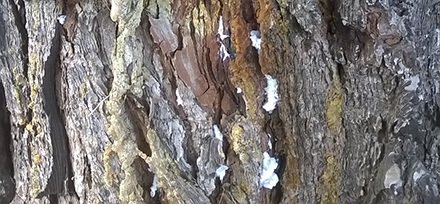As the fight continues to limit impacts to South Australia’s $1.4 billion forest industry from the sap sucking plant pest giant pine scale, gardeners and residents in the Hope Valley area are being asked to report any signs of the destructive pest. Source: Timberbiz
Given the risk giant pine scale poses to Adelaide’s street, park and garden trees, along with South Australia’s forest industry, the South Australian forest sector, state government agencies and local government will continue to take steps to protect our trees from this pest.
As part of an ongoing response against the pest in the Hope Valley and Highbury areas, ForestrySA is this week facilitating the removal of the last known infected trees within the Hope Valley Reservoir Reserve. The program follows the recent detection of the pest, the first in South Australia since 2018, in the area.
A response team made of potentially affected stakeholders and land managers are meeting regularly, including representatives of state government agencies, the South Australian forest sector, local government and others as appropriate. The Department of Primary Industries and Regions (PIRSA) is providing technical advice to the response.
Native to the eastern Mediterranean region, giant pine scale (Marchalina hellenica) causes branch dieback, gradual desiccation and tree death. It feeds exclusively on plants from the pine family, such as pines, firs and spruces.
A priority of the response program is to protect our forest industries through the urgent removal of infested trees, reducing the risk of further spread of the pest. Previous giant pine scale detections at Dernancourt and North Adelaide in 2014 and Highbury in 2018 were successfully controlled using this same approach.
Removal of affected trees remains the best-known option for eliminating giant pine scale, regarded as the quickest and most effective eradication method against the pest. Tree removal also assists in stopping the pest spreading onto other unaffected pines.
“While we recognize the loss of tree canopies and urban forests is an unfortunate process, it is crucial that the giant pine scale insect is removed from our metropolitan trees before it spreads any further, as it would be a biodiversity disaster if this infestation reaches our plantation forests,” South Australian Forest Products Association CEO Nathan Paine said.
“Giant pine scale is a sap sucking insect that feeds on trees from the Pinaceae family, including pine, firs and spruces, and with 128,000 hectares of Radius Pine in South Australia, we need to protect the businesses and the livelihoods of those working in the forest and timber industries,” he said.
“If this insect reaches any of our commercial pine plantations it would have a devastating impact on our state’s economy and regional communities. Forestry in South Australia contributes almost $3 billion to the State’s economy, employs over 21,300 people and there are countless industries that heavily rely on our products, such as residential and commercial builders and the agriculture and horticulture industries to name a few.”
The current phase of the giant pine scale response involves:
- assessing the extent of trees infested with the pest in the affected and surrounding areas, through active surveillance
- responding to pest reports provided by community members
- removing infested trees.
Nationally, giant pine scale is now regarded as an established pest in Australia, notably in parts of outer Melbourne.
In addition to this current operation, surveillance is also being undertaken to determine if the pest has spread further. To date no further concerns have emerged elsewhere in South Australia.
Following the removal of these last infested trees, felled tree material will be processed into landscaping grade product and then quarantined for a minimum of six months to ensure that there is no more living giant pine scale in the product. Giant pine scale cannot survive for long periods away from a living host tree.
SA Water is currently developing a rehabilitation plan for priority areas within its Hope Valley Reservoir Reserve, including where infected pine trees are being removed. This work, which will take place after the quarantine period, will focus on establishing native vegetation as part of the Utility’s broader land management program.
Prior to the felling of any infested trees, wildlife found to be present, including protected animals and the eggs of protected animals, have also been managed appropriately in accordance with relevant legislation.
Surveillance is ongoing while all steps are being made to ensure no risk of spread by the pest, particularly through ongoing surveillance, it is possible that further detections of giant pine scale may be made which may also require the removal of additional trees.
The occurrence of giant pine scale poses no health risk to the local community, or to water quality in the Hope Valley Reservoir.
“The South Australian Forest Products Association are grateful to be working with the South Australian Government on eradicating this biodiversity risk, as the removal of the infested trees will not only protect the industry it will also protect the local environment and the neighbouring urban forests that remain unaffected,” Mr Paine said.
If you see or suspect giant pine scale, report it to the Exotic Plant Pest Hotline on 1800 084 881.








